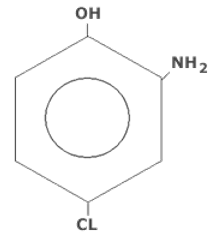
| Parameters | Specification |
|---|---|
| Cas No. | 95-85-2 |
| HPLC | 99% MIN |
| Moisture | 1.00% MAX |
| Melting Point | 139 – 141 ºC |
| Specification of 4-CHLORO 2- AMINO PHENOL (4-CAP) | Doc. No. : PCI/FM-SPEC/002/00 |
| Effective Date : 05.04.2022 | |
| Revision Date : 04.04.2024 | |
| Page No. : 1 of 1 |
| Product | : | 4-CHLORO 2- AMINO PHENOL (4-CAP) |
| CAS no. | : | 95 – 85 – 2 |
| Mol. Wt. | : | 143.57 |
| Empirical Formula | C6H6NOCL |
| SPECIFICATION OF 4-CHLORO 2- AMINO PHENOL | ||
| Sr. No. | Test Parameters | Specification |
| 1 | Appearance | White or Off-White crystalline Powder |
| 2 | Purity by HPLC | 99.0 % Min |
| 3 | Melting Point | 139 – 141 °C |
| 4 | Salt in acetone | 0.50 % Max |
| 5 | Insoluble | 0.050 % Max |
| 6 | Moisture by KF | 1.00 % Max |
| STP of 4-CHLORO 2- AMINO PHENOL (4-CAP) | Doc. No. : PCI/FM-STP/002/00 |
| Effective Date : 05.04.2022 | |
| Revision Date : 04.04.2024 | |
| Page No. : 1 of 5 |
| Instrument | : | HPLC with UV Detector | ||||||||||||||||||
| Standard Preparation | : | Weigh 50 MG of Standard and dissolve in 30 ML Methanol and put on Ultrasonic bath for 5 mins and make up in 50 ML Volumetric Flask with Methanol. | ||||||||||||||||||
| Sample Preparation | : | Weigh 50 MG of Sample and dissolve in 30 ML Methanol and put on Ultrasonic bath for 5 mins and make up in 50 ML Volumetric Flask with Methanol. | ||||||||||||||||||
| Mobile Phase Preparation | : | Mobile Phase A: 1.0 % W/V O-Phosphoric Acid in HPLC Water Mobile Phase B: 100 % HPLC Grade Methanol | ||||||||||||||||||
| Injection Volume | : | 10 Micro Liter | ||||||||||||||||||
| Flow Rate | : | 1.0 ML / Minute | ||||||||||||||||||
| Programming | : | Gradient
|
||||||||||||||||||
| Detector | : | UV Detector at 230 nm | ||||||||||||||||||
| Run Time | : | 41 Minutes | ||||||||||||||||||
| Column | : | Nucleodur C18 ec [250 mm X 4.0 mm, 5 Micron] | ||||||||||||||||||
| Column Temp | : | 40 °C | ||||||||||||||||||
| Calculation | : | Calculate Area Percentage | ||||||||||||||||||
| Remarks: | : | Retention Time / Relative Retention Time shall be in match with that of the standard |
| STP of 4-CHLORO 2- AMINO PHENOL (4-CAP) | Doc. No. : PCI /FM-STP/002/00 |
| Effective Date : 05.04.2022 | |
| Revision Date : 04.04.2024 | |
| Page No. : 2 of 5 |
| Instrument | : | Melting Point Apparatus |
| Procedure | : |
|
| STP of 4-CHLORO 2- AMINO PHENOL (4-CAP) | Doc. No. : PCI/FM-STP/002/00 |
| Effective Date : 05.04.2022 | |
| Revision Date : 04.04.2024 | |
| Page No. : 3 of 5 |
| Reagent | : | Acetone |
| Procedure | : |
|
| Calculation | : | % Salt in Acetone = (W – W1) X 100 Sample Weight |
| STP of 4-CHLORO 2- AMINO PHENOL (4-CAP) | Doc. No. : PCI/FM-STP/002/00 |
| Effective Date : 05.04.2022 | |
| Revision Date : 04.04.2024 | |
| Page No. : 4 of 5 |
| Reagent | : | HCl |
| Procedure | : |
|
| Calculation | : | % Insoluble= (W – W1) X 100 Sample Weight |
| STP of 4-CHLORO 2- AMINO PHENOL (4-CAP) | Doc. No. : PCI/FM-STP/002/00 |
| Effective Date : 05.04.2022 | |
| Revision Date : 04.04.2024 | |
| Page No. : 5 of 5 |
| Instrument | : | Karl Fischer Moisture Analyzer |
| Procedure | : | Derivation of KF Factor |
|
||
| Calculation of KF Factor | : | KF FACTOR = Weight of Water X 1000 |
| Actual Moisture Derivation | ||
|
||
| Calculation of Moisture Content | : | Moisture Content: = B. R. X KF Factor |
| RETECTION TIME | IMPURITY NAME |
| APPROX 8.9 | 4 CP |
| APPROX 19.3 | 2:5 DCNB |
| APPROX 21.6 | 4 CNP |
At Prerana Agrochem, we are dedicated to delivering high-quality specialty chemicals through cutting-edge innovation and sustainable practices.

Copyright © 2025 Prerana Agro Chem PVT. LTD.| Designed by Z Web Solutions